Rinceau

In architecture and the decorative arts, a rinceau (plural rinceaux; from the French, derived from old French rain 'branch with foliage') is a decorative form consisting of a continuous wavy stemlike motif from which smaller leafy stems or groups of leaves branch out at more or less regular intervals. The English term scroll is more often used in English, especially when the pattern is regular, repeating along a narrow zone. In English "rinceau" tends to be used where the design spreads across a wider zone, in a similar style to an Islamic arabesque pattern.
The use of rinceaux is frequent in the friezes of Roman buildings, where it is generally found in a frieze, the middle element of an entablature, just below the cornice. It is also decorated in the jamb ornaments and capitals of Romanesque structures and in friezes and panels of buildings in the various Renaissance styles, where tiny animals or human heads also appear.[1]
The rinceau experienced a return to the simpler Classic style in the 17th century, and in the subsequent century it was applied more freely, without a strict repetition of identical forms.[2]
Gallery
[edit]-
Ancient Greek rinceau on a mosaic of a stag hunt, Pella, Greece, unknown architect or craftsman, 4th century BC
-
Hades and Persephone, c.340 BC, pigments on marble, Museum of the Royal Tombs of Aigai, Vergina, Greece[3]
-
Ancient Greek rinceaux on a krater, by the painter of Copenhagen 4223, 340-320 BC, ceramic, National Archaeological Museum, Madrid, Spain
-
Ancient Greek rinceaux on a larnax of Philip II, 330-320 BC, gold and enamel, Museum of the Royal Tombs of Aigai, Vergina, Greece[4]
-
Polychrome Roman mosaic of Neptune and Amphitrite, c.70 BC, mosaic, Casa di Nettuno e Anfitrite, Herculaneum Archaeological Park, Ercolano, Italy[6]
-
Roman rinceaux at the top of a throne of Apollo, late 1st century BC, marble, Los Angeles County Museum of Art, US
-
Roman rinceaux on a tripod with sphinxes, late 1st century BC-1st century AD, bronze, National Archaeological Museum, Naples, Italy
-
Roman rinceaux on a panel with a griffin from the Villa of Lucio Vero, 2nd century, vitreous paste panel, Palazzo Massimo alle Terme, Rome
-
Late Roman-early Byzantine rinceaux on the Sarcophagus of Constantina, c.340, porphyry, Vatican Museums, Vatican City
-
Late Roman-early Byzantine rinceaux in the Mausoleum of Galla Placidia, Ravenna, Italy, unknown architect or craftsman, 425-450
-
Late Roman-early Byzantine rinceaux in the Baptistery of Neon, Ravenna, unknown architect or craftsman, 5th century
-
Byzantine rinceaux on a ceiling of Basilica of San Vitale, Ravenna, unknown architect or craftsman, begun in c.532 and consecrated in 548[8]
-
Byzantine rinceaux on a ceiling of Basilica of San Vitale, unknown architect or craftsman, begun in c.532 and consecrated in 548[9]
-
Byzantine rinceaux with animals on the Throne of Archbishop Maximian of Ravenna, 546-556, ivory, Archiepiscopal Museum, Ravenna[10]
-
Khmer rinceaux on Banteay Srei, Siem Reap province, Cambodia, unknown architect or sculptor, 10th century
-
Byzantine rinceaux on a panel with peacocks, c.1100, marble, Church of Santa Maria Assunta, Torcello, Italy[11]
-
Romanesque rinceaux on a page from the Bury Bible, by Master Hugo, c.1135-1140, illumination on parchment, Corpus Christi College, University of Cambridge, the UK
-
Romanesque rinceaux on a casket of courtly love, both on the lid and on the rest, c.1180, champlevé enamel om gilded copper, British Museum, London[12]
-
Mughal rinceaux on the Quwwat ul-Islam Mosque from the Qutb Minar complex, Delhi, India, unknown architect, 1198[13]
-
Gothic rinceaux next to the door of the Rouen Cathedral, Rouen, France, unknown architect, 12th century
-
Gothic rinceaux ironwork on a door of the Notre-Dame de Paris, attributed to the locksmith Biscornet, 12th-13th centuries
-
Gothic rinceaux ironwork on an armoire, 14th century, wood and iron, Museum of Decorative Arts, Paris
-
Chinese rinceau on a bowl, 1368-1450, porcelain, Los Angeles County Museum of Art, US
-
Gothic rinceaux on a page of the Codex Salemitanus IX c, 15th century, tempera colors, gold paint, gold leaf, and ink on parchment, Heidelberg University Library, Heidelberg, Germany
-
Gothic rinceau on a page with the adoration of the magi from an illuminated manuscript, 1415-1420, tempera colors, gold paint, gold leaf, and ink on parchment, Getty Center, Los Angeles
-
Gothic rinceau on a leaf from a book of hours, c.1460, parchment with ink, paint, and gold, Walters Art Museum, Baltimore, US
-
Renaissance rinceaux in the Cathedral Basilica of Saint Cecilia, Albi, France, unknown painter, c.1480
-
Gothic rinceaux, part of a circular artwork with musicians playing near a well, by Israhel van Meckenem, 1495-1503, engraving, National Gallery of Art, Washington, D.C., US
-
Islamic rinceaux of the Sheikh Lotfollah Mosque, Isfahan, Iran, designed by architect Ostad Mohammad Reza Isfahani, 1603-1619
-
Baroque rinceaux with putti painted on the boiserie of a room from the Hôtel Colbert de Villacerf, now in the Musée Carnavalet, Paris, unknown architect, sculptor and painter, c.1650[14]
-
Baroque rinceaux in the Hôtel Salé (now the Musée Picasso), Paris, designed by Jean Boulier de Bourges, 1656-1659
-
Baroque rinceaux on a table top with Orpheus, by Annibale Grifoni, 1660-1679, unknown materials, Villa medicea di Cerreto Guidi, Cerreto Guidi, Italy
-
Baroque rinceaux on boiserie in the Galerie d'Apollon, Louvre Palace, by Louis Le Vau and Charles Le Brun, after 1661[16]
-
Baroque marble inlayed rinceaux in the Santa Caterina, Palermo, unknown architect of craftsman, 17th century
-
Brâncovenesc grape rinceau of a railing of the Potlogi Palace, Potlogi, Romania, unknown architect or sculptor, 1698
-
Baroque rinceaux on an armoire, attributed to Nicolas Sageot, c.1710, oak, marquetry of tortoiseshell on a brass background, Museum of Decorative Arts, Paris
-
Baroque rinceaux on a commode, by André-Charles Boulle, c.1710–1720, walnut veneered with ebony, marquetry of engraved brass and tortoiseshell, and gilt-bronze mounts, Metropolitan Museum of Art, New York
-
Rococo rinceaux in the Bibliothèque du Dauphin du Château de Versailles, Palace of Versailles, Versailles, France, unknown architect, early or mid-18th century
-
Mughal and European-influenced rinceaux of the Peacock Gate of the City Palace, Jaipur, India, unknown architect or painter, 1729-1732[17]
-
Neoclassical rinceaux railing in the Belsay Hall, Belsay, Northumberland, the UK, by Sir Charles Monck, 1810-1817
-
Neoclassical rinceaux on a vase, by the Sèvres Porcelain Manufactory, 1814, hard-paste porcelain with platinum background and gilt bronze mounts, Louvre[18]
-
Gothic Revival rinceau on the choir carpet of Notre-Dame de Paris, by the Gobelins Manufactory, 1825-1833, textile, Notre-Dame de Paris[19]
-
Neoclassical rinceaux on a stock certificate, unknown illustrator, 1852, ink on paper, unknown location
-
Renaissance Revival rinceaux with putti of the Fontaine Saint-Michel, Place Saint-Michel, Paris, designed by Gabriel Davioud, 1858-1860
-
Baroque Revival rinceaux with putti on a ceiling in the apartments of the minister of state, currently known as the Napoleon III Apartments, Louvre Palace, unknown architect or sculptor, c.1860
-
Neoclassical rinceaux with a mascaron of Rue des Vinaigriers no. 57, Paris, designed by E. Escudie, 1882
-
Neoclassical rinceaux on a grille at an entrance of the Salle Favart, Paris, probably designed by Louis Bernier, 1893-1898
-
Highly stylized Vienna Secession rinceaux of Peterkův dům, Prague, Czech Republic, by Jan Kotěra and Vilém Tierhier, 1899
-
Art Nouveau painted rinceaux in the Brandversicherungsanstalt, Dresden, Germany, designed by Oswald Haenel, 1899-1901
-
Romanian Revival rinceau on the Gheorghieff Brothers Tomb, Bellu Cemetery, Bucharest, Romania, by Ion Mincu, c.1900
-
Beaux Arts over door with rinceaux in Strada Zborului no. 2, Bucharest, unknown architect or designer, c.1900
-
Gothic Revival cartouche with rinceaux of Strada Temișana no. 4, Bucharest, unknown architect, c.1900
-
Art Nouveau rinceaux around the entrance door of Avenue de Ségur no. 50, Paris, by Gabriel Ruprich-Robert, 1900
-
Art Nouveau rinceaux on the of Lavirotte Building (Avenue Rapp no. 29), Paris, designed by Jules Lavirotte and decorated with sculpture and ceramic tiles made by Alexandre Bigot, 1901
-
Art Nouveau sgraffito rinceaux on the Maison Henri Jacobs (Avenue Maréchal Foch no. 9), Brussels, architect Henri Jacobs, sgraffito by Privat Livemont, 1903[21]
-
Art Nouveau rinceaux on tiles on the Palazzo Pola e Todescan (Via del Campidoglio no. 3), Florence, Italy, by Giovanni Paciarelli, 1903
-
Renaissance Revival fresco with cartouches and foliage spirals on the upper part of the facade of Strada Occidentului no. 11, Bucharest, painter: C. Cora, architect: Cesare Fantoli, 1910[22]
-
Neo-Louis XVI style panel with rinceaux and an urn in the Nicolae T. Filitti/Nae Filitis House (Calea Dorobanților no. 18), Bucharest, by Ernest Doneaud, c.1910[23]
-
Art Nouveau sgraffito rinceaux on Avenue Richard Neybergh no. 160, Brussels, architect Eugène Leman, non attributed sgraffito, 1910[24]
-
Romanian Revival rinceau in the Gheorghe Petrașcu House (Piața Romană no. 5), Bucharest, by Spiru Cegăneanu, 1912[25]
-
Art Nouveau rinceaux in two murals from the Palazzo delle Terme Berzieri, Salsomaggiore Terme, Italy, unknown artist, 1922[26]
-
Postmodern Baroque Revival rinceaux on a box, part of the Le Jardin de Versace collection, designed by Versace and produced by Rosenthal; c.2015, porcelain, unknown location
Notes
[edit]- ^ Cf. J. Ward, Historic Ornament: Treatise on Decorative Art and Architectural Ornament, BiblioBazaar (2009), s.v. Rinceau.
- ^ Cf. A. Speltz, The History of Ornament: Design in the Decorative Arts, Portland (1989), s.v.
- ^ Fortenberry, Diane (2017). THE ART MUSEUM. Phaidon. p. 40. ISBN 978-0-7148-7502-6.
- ^ Robertson, Hutton (2022). The History of Art - From Prehistory to Presentday - A Global View. Thames & Hudson. p. 261. ISBN 978-0-500-02236-8.
- ^ "Temple of Apollo at Didyma". brown.edu. Retrieved 6 March 2024.
- ^ Virginia, L. Campbell (2017). Ancient Room - Pocket Museum. Thames & Hudson. p. 199. ISBN 978-0-500-51959-2.
- ^ Robertson, Hutton (2022). The History of Art - From Prehistory to Presentday - A Global View. Thames & Hudson. p. 323. ISBN 978-0-500-02236-8.
- ^ Eastmond, Anthony (2013). The Glory of Byzantium and early Christendom. Phaidon. p. 81. ISBN 978 0 7148 4810 5.
- ^ Eastmond, Anthony (2013). The Glory of Byzantium and early Christendom. Phaidon. p. 83. ISBN 978 0 7148 4810 5.
- ^ Eastmond, Anthony (2013). The Glory of Byzantium and early Christendom. Phaidon. p. 83. ISBN 978 0 7148 4810 5.
- ^ Eastmond, Anthony (2013). The Glory of Byzantium and early Christendom. Phaidon. ISBN 978 0 7148 4810 5.
- ^ Robertson, Hutton (2022). The History of Art - From Prehistory to Presentday - A Global View. Thames & Hudson. p. 586. ISBN 978-0-500-02236-8.
- ^ Robertson, Hutton (2022). The History of Art - From Prehistory to Presentday - A Global View. Thames & Hudson. p. 444. ISBN 978-0-500-02236-8.
- ^ "LAMBRIS DU CABINET DE L'HÔTEL COLBERT DE VILLACERF". carnavalet.paris.fr. Retrieved 31 August 2023.
- ^ Jacquemart, Albert (2012). Decorative Art. Parkstone International. p. 70. ISBN 978-1-84484-899-7.
- ^ Sharman, Ruth (2022). Yves Saint Laurent & Art. Thames & Hudson. p. 147. ISBN 978-0-500-02544-4.
- ^ Stefan Sagmeister; Jessica Walsh (2018). Beauty. Phaidon. p. 192. ISBN 978 0 7148 7727 3.
- ^ "PAIRE DE VASES « FUSEAU »". amisdulouvre.fr. Retrieved 10 May 2023.
- ^ "tapis de choeur Louis-Philippe". pop.culture.gouv.fr. Retrieved 5 October 2023.
- ^ Jones, Denna, ed. (2014). Architecture The Whole Story. Thames & Hudson. p. 294. ISBN 978-0-500-29148-1.
- ^ Façades Art Nouveau - Les Plus Beaux sgraffites de Bruxelles. [aparté]. 2005. p. 155. ISBN 2-930327-13-8.
- ^ Oprea, Petre (1986). Itinerar Inedit prin Case Vechi din București (in Romanian). Editura Sport-Turism. p. 59.
- ^ Marinache, Oana (2015). Ernest Donaud - visul liniei (in Romanian). Editura Istoria Artei. p. 79. ISBN 978-606-94042-8-7.
- ^ Façades Art Nouveau - Les Plus Beaux sgraffites de Bruxelles. [aparté]. 2005. p. 103. ISBN 2-930327-13-8.
- ^ Mariana Celac, Octavian Carabela and Marius Marcu-Lapadat (2017). Bucharest Architecture - an annotated guide. Ordinul Arhitecților din România. p. 80. ISBN 978-973-0-23884-6.
- ^ Benzi, Fabio (2004). Art Déco (in Italian). Giunti. p. 39. ISBN 88-09-03548-8.
See also
[edit]External links
[edit]- Decorating with Art, Antiques and Collectibles
- Home Economics Archive: Tradition, Research, History (HEARTH)
An e-book collection of over 1,000 books on home economics spanning 1850 to 1950, created by Cornell University's Mann Library. Includes several hundred e-books on decorative art and design, particularly that created within the home. - Victoria and Albert Museum
- The Bard Graduate Center (BGC) for Studies in the Decorative Arts, Design and Culture
- Parsons/Cooper-Hewitt Program in the History of Decorative Arts & Design
- Digital Library for the Decorative Arts and Material Culture - electronic resources
- Metropolitan Museum of Art American decorative arts collection
- National Gallery of Art decorative arts collection


![Hades and Persephone, c.340 BC, pigments on marble, Museum of the Royal Tombs of Aigai, Vergina, Greece[3]](http://upload.wikimedia.org/wikipedia/commons/thumb/f/f8/Hades_and_Persephone%2C_Vergina.jpg/445px-Hades_and_Persephone%2C_Vergina.jpg)

![Ancient Greek rinceaux on a larnax of Philip II, 330-320 BC, gold and enamel, Museum of the Royal Tombs of Aigai, Vergina, Greece[4]](http://upload.wikimedia.org/wikipedia/commons/thumb/e/eb/%CE%98%CE%B5%CF%83%CF%83%CE%B1%CE%BB%CE%BF%CE%BD%CE%AF%CE%BA%CE%B7_-_%CE%91%CF%81%CF%87%CE%B1%CE%B9%CE%BF%CE%BB%CE%BF%CE%B3%CE%B9%CE%BA%CF%8C_%CE%9C%CE%BF%CF%85%CF%83%CE%B5%CE%AF%CE%BF_1443.jpg/383px-%CE%98%CE%B5%CF%83%CF%83%CE%B1%CE%BB%CE%BF%CE%BD%CE%AF%CE%BA%CE%B7_-_%CE%91%CF%81%CF%87%CE%B1%CE%B9%CE%BF%CE%BB%CE%BF%CE%B3%CE%B9%CE%BA%CF%8C_%CE%9C%CE%BF%CF%85%CF%83%CE%B5%CE%AF%CE%BF_1443.jpg)
![Ancient Greek rinceaux on a capital from the ruins of the Temple of Apollo at Didyma, Turkey, unknown architect or sculptor, c.300-150 BC[5]](http://upload.wikimedia.org/wikipedia/commons/thumb/f/f5/Didyma_2013-03-25zd.jpg/383px-Didyma_2013-03-25zd.jpg)
![Polychrome Roman mosaic of Neptune and Amphitrite, c.70 BC, mosaic, Casa di Nettuno e Anfitrite, Herculaneum Archaeological Park, Ercolano, Italy[6]](http://upload.wikimedia.org/wikipedia/commons/thumb/e/e4/Neptune_Amphitrite_mosaic_Herculaneum.jpg/376px-Neptune_Amphitrite_mosaic_Herculaneum.jpg)
![Polychrome Roman rinceau in an arabesque on the Ara Pacis, Rome, unknown architect and sculptors, 13-9 BC[7]](http://upload.wikimedia.org/wikipedia/commons/thumb/c/c6/Lupercale_a_colori.JPG/191px-Lupercale_a_colori.JPG)



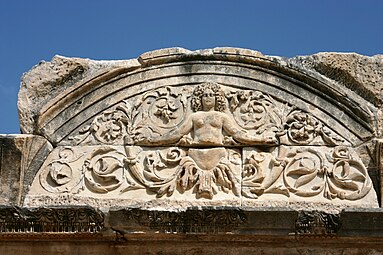




![Byzantine rinceaux on a ceiling of Basilica of San Vitale, Ravenna, unknown architect or craftsman, begun in c.532 and consecrated in 548[8]](http://upload.wikimedia.org/wikipedia/commons/thumb/a/a5/Basilica_of_San_Vitale_-_Lamb_of_God_mosaic.jpg/319px-Basilica_of_San_Vitale_-_Lamb_of_God_mosaic.jpg)
![Byzantine rinceaux on a ceiling of Basilica of San Vitale, unknown architect or craftsman, begun in c.532 and consecrated in 548[9]](http://upload.wikimedia.org/wikipedia/commons/thumb/9/94/Ravenna_San_Vitale_204.jpg/383px-Ravenna_San_Vitale_204.jpg)
![Byzantine rinceaux with animals on the Throne of Archbishop Maximian of Ravenna, 546-556, ivory, Archiepiscopal Museum, Ravenna[10]](http://upload.wikimedia.org/wikipedia/commons/thumb/d/dd/Ravenna_Museo_Arcivescovile_174.jpg/360px-Ravenna_Museo_Arcivescovile_174.jpg)
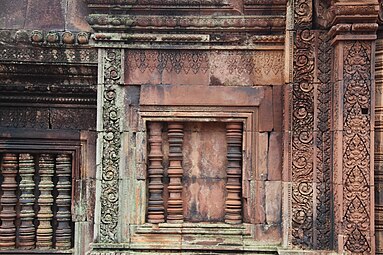
![Byzantine rinceaux on a panel with peacocks, c.1100, marble, Church of Santa Maria Assunta, Torcello, Italy[11]](http://upload.wikimedia.org/wikipedia/commons/thumb/a/af/Scuola_veneto-bizantina%2C_plutei_marmorei_del_1050-1100_ca.jpg/258px-Scuola_veneto-bizantina%2C_plutei_marmorei_del_1050-1100_ca.jpg)

![Romanesque rinceaux on a casket of courtly love, both on the lid and on the rest, c.1180, champlevé enamel om gilded copper, British Museum, London[12]](http://upload.wikimedia.org/wikipedia/commons/thumb/5/52/K%C3%A4stchen_mit_Hof-_und_Liebesszenen-WUS04628.jpg/383px-K%C3%A4stchen_mit_Hof-_und_Liebesszenen-WUS04628.jpg)
![Mughal rinceaux on the Quwwat ul-Islam Mosque from the Qutb Minar complex, Delhi, India, unknown architect, 1198[13]](http://upload.wikimedia.org/wikipedia/commons/thumb/9/9b/Calligraphy_on_the_arches_of_Quwwat_Ul-Islam_mosque%2C_Qtub_minar_complex.jpg/340px-Calligraphy_on_the_arches_of_Quwwat_Ul-Islam_mosque%2C_Qtub_minar_complex.jpg)






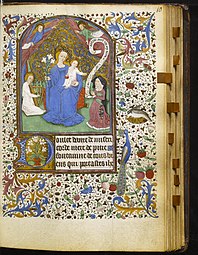



![Baroque rinceaux with putti painted on the boiserie of a room from the Hôtel Colbert de Villacerf, now in the Musée Carnavalet, Paris, unknown architect, sculptor and painter, c.1650[14]](http://upload.wikimedia.org/wikipedia/commons/thumb/f/f0/H%C3%B4tel_Colbert_de_Villacerf_3.jpg/191px-H%C3%B4tel_Colbert_de_Villacerf_3.jpg)
![Baroque rinceaux on the chest for Louis XIV's gems, mid-17th century, repoussé and chiselled gold over a wooden core, Louvre[15]](http://upload.wikimedia.org/wikipedia/commons/thumb/8/85/My_kind_of_jewelry_box_%2830079398526%29.jpg/332px-My_kind_of_jewelry_box_%2830079398526%29.jpg)

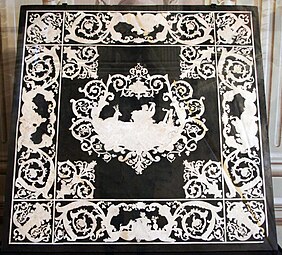
![Baroque rinceaux on boiserie in the Galerie d'Apollon, Louvre Palace, by Louis Le Vau and Charles Le Brun, after 1661[16]](http://upload.wikimedia.org/wikipedia/commons/thumb/0/0f/Detail_of_the_Galerie_d%27Apollon_%2836%29.jpg/155px-Detail_of_the_Galerie_d%27Apollon_%2836%29.jpg)



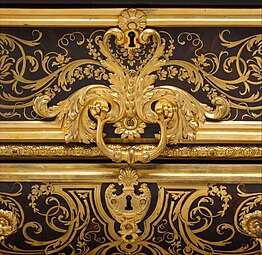

![Mughal and European-influenced rinceaux of the Peacock Gate of the City Palace, Jaipur, India, unknown architect or painter, 1729-1732[17]](http://upload.wikimedia.org/wikipedia/commons/thumb/8/82/India_2015-187_%2817164938015%29.jpg/340px-India_2015-187_%2817164938015%29.jpg)

![Neoclassical rinceaux on a vase, by the Sèvres Porcelain Manufactory, 1814, hard-paste porcelain with platinum background and gilt bronze mounts, Louvre[18]](http://upload.wikimedia.org/wikipedia/commons/thumb/f/f4/Pair_of_Spindle_Vases_-_OA_11090_-_Louvre_%2808%29.jpg/306px-Pair_of_Spindle_Vases_-_OA_11090_-_Louvre_%2808%29.jpg)
![Gothic Revival rinceau on the choir carpet of Notre-Dame de Paris, by the Gobelins Manufactory, 1825-1833, textile, Notre-Dame de Paris[19]](http://upload.wikimedia.org/wikipedia/commons/thumb/9/93/Notre-Dame_de_Paris_-_Tapis_monumental_du_ch%C5%93ur_-_028.jpg/383px-Notre-Dame_de_Paris_-_Tapis_monumental_du_ch%C5%93ur_-_028.jpg)








![Beaux Arts rinceau on the Petit Palais, Paris, by Charles Giraud, 1900[20]](http://upload.wikimedia.org/wikipedia/commons/thumb/4/42/PetitPalaisParisIngresso.jpg/191px-PetitPalaisParisIngresso.jpg)





![Art Nouveau sgraffito rinceaux on the Maison Henri Jacobs (Avenue Maréchal Foch no. 9), Brussels, architect Henri Jacobs, sgraffito by Privat Livemont, 1903[21]](http://upload.wikimedia.org/wikipedia/commons/thumb/6/65/Maison_Henri_Jacobs_-_Sgraffite_1.JPG/620px-Maison_Henri_Jacobs_-_Sgraffite_1.JPG)

![Renaissance Revival fresco with cartouches and foliage spirals on the upper part of the facade of Strada Occidentului no. 11, Bucharest, painter: C. Cora, architect: Cesare Fantoli, 1910[22]](http://upload.wikimedia.org/wikipedia/commons/thumb/c/c4/11_Strada_Occidentului%2C_Bucharest_%2805%29.jpg/314px-11_Strada_Occidentului%2C_Bucharest_%2805%29.jpg)
![Neo-Louis XVI style panel with rinceaux and an urn in the Nicolae T. Filitti/Nae Filitis House (Calea Dorobanților no. 18), Bucharest, by Ernest Doneaud, c.1910[23]](http://upload.wikimedia.org/wikipedia/commons/thumb/f/f5/18_Calea_Doroban%C8%9Bilor%2C_Bucharest_%2802%29.jpg/659px-18_Calea_Doroban%C8%9Bilor%2C_Bucharest_%2802%29.jpg)
![Art Nouveau sgraffito rinceaux on Avenue Richard Neybergh no. 160, Brussels, architect Eugène Leman, non attributed sgraffito, 1910[24]](http://upload.wikimedia.org/wikipedia/commons/thumb/9/97/160_avenue_Richard_Neybergh_Laeken_02.jpg/383px-160_avenue_Richard_Neybergh_Laeken_02.jpg)
![Romanian Revival rinceau in the Gheorghe Petrașcu House (Piața Romană no. 5), Bucharest, by Spiru Cegăneanu, 1912[25]](http://upload.wikimedia.org/wikipedia/commons/thumb/1/1b/5_Pia%C8%9Ba_Roman%C4%83%2C_Bucharest_%2834%29.jpg/190px-5_Pia%C8%9Ba_Roman%C4%83%2C_Bucharest_%2834%29.jpg)
![Art Nouveau rinceaux in two murals from the Palazzo delle Terme Berzieri, Salsomaggiore Terme, Italy, unknown artist, 1922[26]](http://upload.wikimedia.org/wikipedia/commons/thumb/7/7c/Galileo_chini%2C_autunno_e_primavera%2C_1922%2C_01.jpg/417px-Galileo_chini%2C_autunno_e_primavera%2C_1922%2C_01.jpg)

